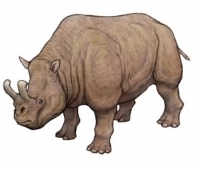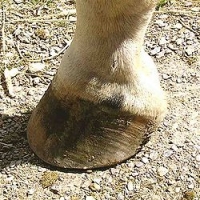| | | 大型草食性哺乳動物有蹄類的一目。第三趾特別發達﹐餘趾不發達或完全退化﹐因趾為單數﹐故名。無鎖骨﹐不反芻﹐盲腸大﹐如驢﹑馬﹑犀﹑貘等。 | |  奇蹄目 奇蹄目 | |
奇蹄目perissodactyla
奇蹄目是哺乳動物下的一個目。包括有奇數腳趾的動物。原始奇蹄動物的腳趾是前三後四,現生的奇蹄動物貘(tapir)就是這樣的腳趾結構。奇蹄目成員胃簡單,不具備偶蹄目部分成員那樣多的胃室,但盲腸大而呈囊狀可協助消化植物纖維。現存的奇蹄目有三個亞目,分別是馬型亞目,hippomorpha(包括馬科和已經滅絶的雷獸科〕,爪獸亞目,ancylopoda(已經滅絶〕和角型亞目,ceratomorpha(包括貘科和犀科〕。奇蹄目的化石非常豐富。奇蹄目史前曾是十分繁盛的種群,分化出形態各異的種類。史前的奇蹄動物包括爪獸(chalecothere),巨犀(indricothere)等。現代的奇蹄目整體呈衰落狀態。由於偶蹄目更能適合消化植物纖維,所以奇蹄目的生態位被後起的偶蹄目逐漸取代。
哺乳綱。包括小部分大型草食性有蹄動物。僅第三趾特別發達,其餘各趾或不發達,或完全退化,趾端具蹄。頭部有角或無角,生角者係表皮的衍生物,終生不脫換,與鹿類和牛、羊類的角都不同。門齒上下頜均存在,適於切草,犬齒存在或退化,臼齒齒冠高,咀嚼面寬闊,其上有復雜的棱脊,適於研磨草料。胃為單室胃。這類不反芻的食草動物,都有很大的盲腸和擴大的結腸,微生物在此像在反芻動物瘤胃內那樣對纖維質食物進行發酵分解。肝無膽囊。分為3科:貘科、犀科和馬科,其中貘科分佈限於中美、南美和馬來半島。
進化
奇蹄目動物是由古新世的踝節目動物進化而來。基本上從始新世開始分化。
哺乳綱的1目,因趾數多為單數而得名。無鎖骨,股骨具第3轉子;前後肢軸均通過第3趾支持體重。現生種牙齒數36~44枚;具散漫狀蛻膜胎盤和雙角子宮;乳頭鼠鼷位;睾丸降於陰囊或無陰囊;胃簡單;盲腸大並呈囊狀;體長200~400釐米,體重200~3000千克。奇蹄目下分馬形亞目和貘形亞目,包括滅絶的類型在內,共有10多個科。現在衹有馬科、貘科和犀科3科7屬17種。
在第三紀初期,多數奇蹄類是小型動物,最古類型的前肢各有4趾,後肢均為3趾。在各地發現的中、上新統的三趾馬化石,四肢兩旁的側趾逐漸縮小,而現存馬科動物的四肢側趾甚至消失,第3趾高度發達,同時四肢也高度特化,肱骨和股骨很短,橈骨和脛骨特別延長,這反映出馬科動物的遠祖從適應森林泥土躍行到逐漸適應草原奔馳的過程。
貘形類是最古老的奇蹄類,在係統上和犀類比較近。現生貘在骨骼和牙齒的基本構造上還保留着第三紀初期的許多原始性質,如前足4趾,後足3趾,四肢粗短等。犀類化石在奇蹄目中種類最多,分支最復雜,分佈亦廣。原始類型前肢4趾,後肢5趾;後期犀類前肢4~3趾;頭骨延長並增大;前臼齒臼齒化,高冠;門齒從有到無。現存犀類種類已很少,仍保留着一些原始特徵,如有的尚存上、下門齒,頭骨細長,臼齒次高冠或次低冠;具獨角或雙角。
奇蹄目的現生馬類棲居草原和荒漠,活動於多山地帶或高原的開闊地區,有的耐幹熱,有的耐幹寒;貘類多棲息在熱帶叢林及水源充足的沼澤地區;現代犀類多棲息於悶熱而潮濕的森林、叢林或蘆葦叢中。現存馬類主要分佈於亞洲和非洲,在亞洲可達北緯50多度,計有2屬8種。貘類見於亞洲南部和美洲,現生者僅1屬4種。犀類現在僅分佈在亞洲和非洲,計4屬5種。
奇蹄類除有科學研究的價值外,在動物園展出中亦占重要地位,其中犀牛類又是珍貴的藥用資源動物。某些野生馬類還可與同類的傢畜雜交,供改良育種的科學實驗用。各國已采取措施,積極保護這類珍稀動物。 | 奇蹄目(化石) Perissodactyla (fossil) | jiti mu(huashi)
奇蹄目(化石)
奇蹄目哺乳動物是各門類脊椎動物中,其進化歷史被研究得最清楚的 1類。這類動物的趾(指)數常為奇數,腳的中軸通過中趾,第1趾(大拇指)和第5趾一般都已消失,這樣,前後腳通常衹有 3個趾起作用,在進步的馬類中甚至衹有 1個趾。多數動物趾端為蹄,但有一科指端為爪。在奇蹄類的踝部,距骨近端有一雙重隆起的滑車形的面,以與脛骨相關節,遠端與踝部其他骨頭相連處則為一扁平的面。奇蹄類的股骨,在其骨幹的外側有一顯著的突起,名第三轉子。這類動物的門齒通常齊全,組成一剪割植物的有效器官,犬齒退化或消失;前臼齒在進化過程中逐漸趨嚮高度臼齒化。
現存奇蹄類,衹有馬、犀、貘 3類,但在地質歷史時期內,除這 3類動物的遠近祖先外,還有雷獸、爪獸、古獸等奇蹄動物。
目前已知最古老的奇蹄動物是發現於北美和歐洲的大約5500萬年前的始馬 (Hyracotherium),又被譯名為始祖馬,因為它是迄今所知最早的馬化石。亞洲也曾發現過此屬動物,但時代稍晚。北美是馬科進化發展的中心,早第三紀期間,由早始新世的始馬幾乎直綫地發展出中始新世的山馬,晚始新世的後馬,早漸新世的中馬,中晚漸新世的細馬。其他大陸這時雖也曾有馬類的發展,如中國的黔馬 (Qianohippus),但不是進化的主支。新第三紀期間,馬類多次由北美遷往其他大陸,中國中新世的安琪馬,中新—上新世的三趾馬都是由北美遷入的。第四紀的真馬(Equus)也源於北美〔見馬科(化石)〕。
與馬科係統關係最為接近的是古獸科。這一科動物的歷史很短,衹見於始新世和漸新世,漸新世以後便絶跡了。歐洲是這類動物的發展中心。除歐洲外,僅中國有少量化石發現。這類動物的牙齒似馬,身材似小犀,鼻子似貘,前後足都衹有3趾。
雷獸科的歷史也很短暫。早始新世出現最早的雷獸──蘭布達獸 (Lambdotherium),衹有犬那樣大,至中漸新世已發展成笨重的龐然大物,肩高可達 2米,中漸新世以後突然消失。從開始出現到最後絶滅,雷獸的前足都有4趾,外趾不退化,後足有3趾。這類動物頭骨很原始,牙齒齒冠不高,下臼齒內側有兩個丘形齒尖,外側的齒尖發展成 W形脊。下臼齒由兩個前後相連 V形脊組成。早—中始新世的雷獸主要發展於北美,亞洲也有少數化石發現。晚始新世和早漸新世,亞洲的雷獸很繁盛,屬種非常多,其中有些嚮西擴展到東歐。
爪獸科動物的牙齒與雷獸相似,但身體遠不如雷獸笨重,如歐洲大陸的巨爪獸(Macrotherium)衹有馬那麽大,頭骨及體形輪廓亦像馬。不同之處在於它腿長,腳甚短,每腳有3趾,趾端有爪,而不是蹄。據推測,這種動物成小群地生活在河邊,以其爪挖掘植物根為食。爪獸科延續的歷史甚長,從始新世開始有其化石,一直到人類出現後纔絶滅。但縱觀其整個進化歷史,這類動物始終沒有非常繁盛過。早第三紀期間,進化速度快,屬種相對也較多,自中新世以後,形態上變化不大(見圖爪獸復原圖)。中國早第三紀和新第三紀地層中都有其化石發現。
現在的犀衹有非洲的兩個種和亞洲的 3個種。但在第三紀,犀繁盛而多樣,有善於長跑的,有適應於水邊生活的,有食嫩葉的,也有食幹草的。按照譜係關係,犀科分為跑犀亞科、兩棲犀亞科和真犀亞科3個亞科。
跑犀亞科出現於始新世中期,漸新世達到其全盛時期,以後漸趨消失。在北美和亞洲發現的漸新世的跑犀(Hyracodon),身材小巧,細長的四肢適於迅速奔跑。前足4趾,後足3趾;上臼齒齒冠成Π形齒脊,下臼齒齒冠為兩個新月脊。這些脊形齒顯示出草食食性。
兩棲犀亞科興起於始新世晚期,從一開始它便是大而 | |  奇蹄目 百科大全 奇蹄目 百科大全 奇蹄目 百科大全 奇蹄目 百科大全
奇蹄目
Perissodactyla
哺乳綱的1目,因趾數多為單數而得名。無鎖骨,股骨具第3轉子;前後肢軸均通過第3趾支持體重。現生種牙齒數36~44枚;具散漫狀蛻膜胎盤和雙角子宮;乳頭鼠鼷位;睾丸降於陰囊或無陰囊;胃簡單;盲腸大並呈囊狀;體長200~400釐米,體重 200~3000千克。奇蹄目下分馬形亞目和貘形亞目,包括滅絶的類型在內,共有10多個科。現在衹有馬科、貘科和犀牛科3科7屬17種。
在第三紀初期,多數奇蹄類是小型動物,最古類型的前肢各有4趾,後肢均為3趾。在各地發現的中、上新統的三趾馬化石,四肢兩旁的側趾逐漸縮小,而現存馬科動物的四肢側趾甚至消失,第 3趾高度發達,同時四肢也高度特化,肱骨和股骨很短,橈骨和脛骨特別延長,這反映出馬科動物的遠祖從適應森林泥土躍行到逐漸適應草原奔馳的過程。
貘形類是最古老的奇蹄類,在係統上和犀類比較近。現生貘在骨骼和牙齒的基本構造上還保留着第三紀初期的許多原始性質,如前足4趾,後足3趾,四肢粗短等。
犀類化石在奇蹄目中種類最多,分支最復雜,分佈亦廣。原始類型前肢4趾,後肢5趾;後期犀類前肢4~3趾;頭骨延長並增大;前臼齒臼齒化,高冠;門齒從有到無。現存犀類種類已很少,仍保留着一些原始特徵,如有的尚存上、下門齒,頭骨細長,臼齒次高冠或次低冠;具獨角或雙角。
奇蹄目的現生馬類棲居草原和荒漠,活動於多山地帶或高原的開闊地區,有的耐幹熱,有的耐幹寒;貘類多棲息在熱帶叢林及水源充足的沼澤地區;現代犀類多棲息於悶熱而潮濕的森林、叢林或蘆葦叢中。
現存馬類主要分佈於亞洲和非洲,在亞洲可達北緯50多度,計有2屬8種。貘類見於亞洲南部和美洲,現生者僅1屬4種。犀類現在僅分佈在亞洲和非洲,計4屬5種。
奇蹄類除有科學研究的價值外,在動物園展出中亦占重要地位,其中犀牛類又是珍貴的藥用資源動物。某些野生馬類還可與同類的傢畜雜交,供改良育種的科學實驗用。各國已采取措施,積極保護這類珍稀動物。
(馮祚建)
| | - lat.: Perissodactyla
| | | 馬 | 馬科 | 野生動物 | 汽車 | 動物 | 哺乳動物 | 犀科 | 荒誕派戲劇 | | 哺乳類 | 百科辭典 | 斑馬屬 | 生物 | 進化 | 古生物 | 傳說 | 斑馬 | | 古生物學 | 生物學 | 導演 | 戲麯 | 百科大全 | 更多結果... |
| | | | |
|
|